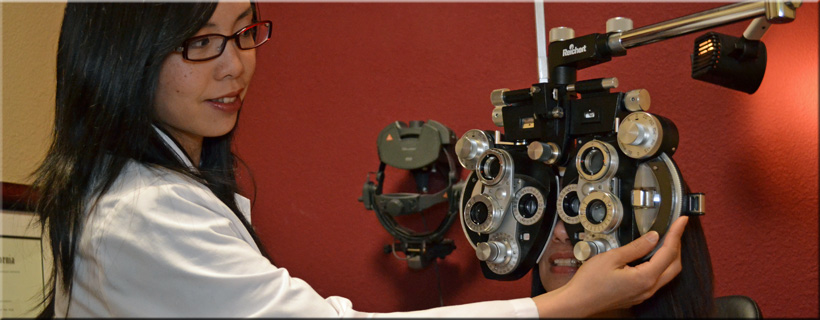|
Optima Optometry
Expert Eye Care. Quality Eyewear. Service Excellence.
|
|
| (408) 247-5102 |
Eye Examinations
Routine eye exams can detect vision problems, eye disease and general health problems before you are aware a problem exists.
At Optima Optometry, our comprehensive eye and vision examination includes a patient history and battery of tests, including
visual acuity measurements, depth perception, color vision, eye muscle movement, peripheral or side vision,
keratometry testing, refraction testing, eye focusing, eye teaming, eye movement testing,
evaluation of the cornea, eyelids, conjunctiva and surrounding eye tissue,
as well as evaluation of the lens, retina and posterior section of the eye.
These tests can help diagnose eye conditions, such as:
Patient History Review
A patient history helps to determine any symptoms the individual is experiencing, when they began,
the presence of any general heath problems, medications taken and occupational or environmental conditions that may be affecting vision.
The doctor will ask about any eye or vision problems you may be having and about your overall health.
The doctor will also ask about any previous eye or health conditions of you and your family members.
Visual Acuity
Visual acuity measurements evaluate how clearly each eye is seeing.
As part of the testing, you are asked to read letters on distance and near reading charts.
The results of visual acuity testing are written as a fraction such as 20/40.
When testing distance vision, the top number in the fraction is the standard distance at which testing is done, twenty feet.
The bottom number is the smallest letter size you were able to read.
A person with 20/40 visual acuity would have to get within 20 feet of a letter that should be seen at 40 feet in order to see it clearly.
Normal distance visual acuity is 20/20.
Preliminary Tests
Preliminary testing may include evaluation of specific aspects of visual function and eye health such as depth perception,
color vision, eye muscle movements, peripheral or side vision, and the way your pupils respond to light.
Keratometry
This test measures the curvature of the cornea, the clear outer surface of the eye,
by focusing a circle of light on the cornea and measuring its reflection.
This measurement is particularly critical in determining the proper fit for contact lenses.
Refraction
Refraction is conducted to determine the appropriate lens power needed to compensate for any refractive error
(nearsightedness, farsightedness, or astigmatism). Using an instrument called a phoropter,
your optometrist places a series of lenses in front of your eyes and measures how they focus
light using a hand held lighted instrument called a retinoscope.
Eye Focusing, Eye Teaming, and Eye Movement Testing
Assessment of accommodation, ocular motility and binocular vision determines how well the eyes focus, move and work together.
In order to obtain a clear, single image of what is being viewed, the eyes must effectively change focus, move and work in unison.
This testing will look for problems that keep your eyes from focusing effectively or make using both eyes together difficult.
Eye Health Evaluation
External examination of the eye includes evaluation of the cornea, eyelids, conjunctiva and surrounding eye tissue
using bright light and magnification.
Evaluation of the lens, retina and posterior section of the eye may be done through a dilated pupil
to provide a better view of the internal structures of the eye.
Supplemental Testing
Additional testing may be needed based on the results of the previous tests to confirm or rule out possible problems,
to clarify uncertain findings, or to provide a more in-depth assessment.
At the completion of the examination, your optometrist will assess and evaluate the results of the testing
to determine a diagnosis and develop a treatment plan. He or she will discuss with you the nature of any visual or eye health problems
found and explain available treatment options.
In some cases, referral for consultation with, or treatment by, another optometrist or other health care provider may be indicated.
If you have questions regarding any eye or vision conditions diagnosed, or treatment recommended,
don't hesitate to ask for additional information or explanation from your doctor.
|
|
